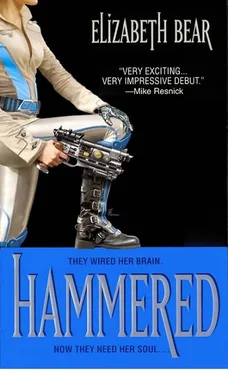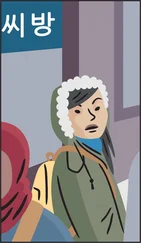Forster nodded inside his heated suit, leaning closer to examine the smooth, mottled wall: polished as paneling, but without obvious joins. “I would swear this was organic.”
“It appears to be. Akin to cellulose, if you can believe it. I thought you would find that interesting, as a biologist.”
“Colonel. You’re telling me this is a tree ?”
Valens laughed, working to make it seem charming and easy. “No, it’s a starship.”
“The other one was carbon, ceramics, and alloy, though. That tells me — two different civilizations. Or years of tech development. They lost one ship here and sent another looking? Which raises the unsettling question of what they ran into.”
“I’m not going to tell you that the hull wasn’t grown, Dr. Forster. It incorporates nanotube technology in addition to the organics, however. Carbon, like the space tethers.”
“Strong. And it’s held up for some thousands of years, based on areological analysis. Do we have any indication that there was a pilot, rather than this being the remains of some autonomous starfaring vegetable?”
“Other than it being laced with tunnels and chambers, and some things that might be furniture? There’s not a damned thing that looks like an instrument panel, if that’s what you mean.”
“Hmmm.” Forster reached past the hanging lights in their yellow cages and ran his gloved fingers along the knobby ridge at the center of the double-arched ceiling. “Colonel.”
Valens licked his lips behind the faceplate. “Something?”
“These are handholds. Colonel, I’m going to go out on a big old limb with a hypothesis. This appears to be a ladder.”
“Why would you want a ladder on the ceiling?” I bet I know the answer to that.
Charlie was reasonably fresh off the shuttle from Friendship Station. “For freefall, Colonel. Something to haul yourself about with.”
“Ah.” Valens tilted his head back, reaching up to push one of the work lights to the side. “Come on. Let’s go look at the thing that might be a bridge.”
It was a long walk. Valens didn’t see how the echoing space could have housed a command crew’s instruments without some sign of where they had been removed, and he was wary of jumping to conclusions, no matter how tempting. For one thing, presuming that the engines were aft, this large chamber wasn’t anywhere near the front of the ship — despite cracked and shattered crystal panels that had once hung against the walls. “Those look like view screens or interface panels. But I don’t see anything like controls.” He shook his head inside his helmet. “So how did they fly the damned thing?”
“And why aren’t there any bodies on this one, either?” Forster wandered in slow circles around the diameter of the room, footsteps stirring swirls in the rust-colored fines that blanketed the chamber. As large as the center ring of a circus, the “bridge” contained nothing except those panels and a number of raised concave structures that invited comparison to unpadded papasan chairs. Or perhaps bowls on stilts. Here, there was metal — flexible coils like segmented snakes lay across the floor or dangled over the papasan chairs, tangles of hair-fine wires drooping from the tips.
Forster selected one and raised it in a gloved hand, holding it up to the light. “Interesting.”
Valens wandered over, leaning into Charlie’s light. “Some of the wires are sheared off. Broken,” he commented after a minute. “What’s that dark stain?”
“Given that — without oxygen, in the cold, without microbes — it could have lasted this long…” Forster laid the cable down on the papasan and reached into his kit for scrapers and sample envelopes. “Blood, Colonel Valens. I think it’s blood.”
0930 hours, Wednesday 6 September, 2062
Jefferson Avenue
Hartford Hospital Medical Offices
Hartford, Connecticut
“Did it bother you to be called a baby killer?”
I shrug and start unbuttoning my shirt. “No more than it might bother you, Simon. What the hell brought that on?”
My neurologist — who also happens to be a friend — shrugs and turns his back to give me a little privacy. He’s already taken my vitals. We’ve long since gotten past the first-names stage. Never mind the silliness with paper sheets and hospital johnnies.
The office is cold. I’ve spent an awful lot of my life perched on examining tables, and the percentage gets higher every year. I let my question hang on the air, but Simon doesn’t answer. Instead, he turns on the water and starts soaping his arms to the elbow.
I drape my shirt over a straight-backed green plastic chair and unbuckle my holster before skinning my jeans off, too. The boots are already neatly side-by-side on the floor under the chair seat. I keep my undershirt and panties on. I got out of the habit of wearing a bra when my burns were still tender. Never really needed one anyway, except for running.
I change the subject. “Did you get those pills analyzed for me, Simon?”
He turns back as I put my good-side foot on the black rubber step and lift myself up on to the examining table. “I did,” he answers. “Where did you get that stuff, Jenny?”
Lifting my shoulders, I lie facedown on the sterile paper-covered table. “Street.”
His hands are very gentle as he pushes my shirt up over the long-faded ridges of scar running the length of my spine. Cool latex-wrapped fingers find the lumps of the nanoprocessors at the small of my back, the nape of the neck. “Some minor inflammation here, Jen. Any soreness?”
“It hurts less than physical therapy,” I answer.
He grunts. “What doesn’t? What have you been taking for it?”
“The usual. Booze, caffeine, aspirin.”
“You look like you’ve lost weight.”
I sigh and press my face into the padded headrest. Paper crinkles against my forehead and cheek. “I’m clean. Promise. Years now.” Change the subject. “Simon, you look tired.”
“I was up late. So how did you happen to get possession of a half-dozen tabs of rigathalonin?”
“It is Hammer?” I am sure he feels me stiffen. “I didn’t take any.”
“Nearly, and I know you didn’t, unless you got really lucky. It’s tainted. A third of the pills.”
“I knew that.” Three more deaths this week. “What do you mean nearly?”
“I mean, it’s nearly rigathalonin. It’s a closely related drug, at least — and there’s traces of something else in it, too. Probably from inadequately cleaned equipment. Routine testing would have revealed it.”
“So how did it wind up in Hartford? And did you identify a serial number?” I wince as he probes around the edge of the prosthetic arm, feeling the scarring. There’s a synthetic mesh woven into my deltoid and what’s left of the upper arm musculature on that side, anchored to my scapula to support the weight of the arm. There’s some other stuff in there, too, all knitted together with a mass of scar tissue and baling wire.
It hurts when he touches the place where the skin chafes around the point of contact, flesh to metal.
“Yah. Canadian Consolidated Pharmacom. Listed as a destroyed batch. Which answers your first question.”
“Somebody stole it and smuggled it out to sell.”
“Right. Ready for the readings?”
I nod against the headrest. The air slides cold across my back.
“Pinprick,” Simon warns. Frigid alcohol defines a path across my skin, and then the tug and wince of wires going in at the base of my spine, just above the pelvis. A weighty, coiled cord lies on my butt like a snake. So much practiced is Simon that he gets it in on the first try. “Again,” and he links to the nanoprocessor that hugs my cervical vertebrae as well.
Читать дальше












